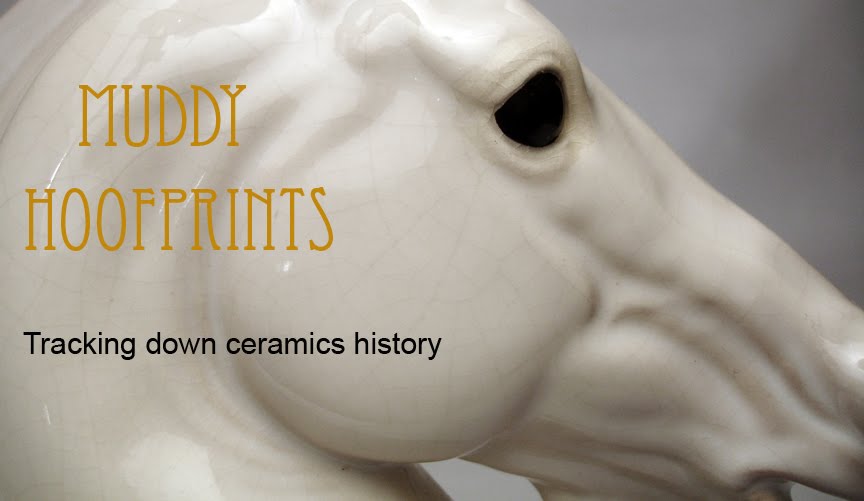Spray can gloss on OF horses? Yes, people did.
Right is the horse as it was presented to me, a glossy.
Left is the cleaned leg in prep for restoration.
Fired gloss does not wipe off with alcohol.
Before cleaning.
I mention this because I have been fooled by horses that were supposed to be mint and untouched. When I started cleaning them in preparation for a show, I found cosmetic work on their factory flaws and normal markings. Fortunately for me, my interest in the pieces was not reduced by clearing away these things. Other collectors, with different specialties in the hobby, may not feel the same way.
After cleaning.
More factory underglaze rub-off spots and an undecorated foreleg came to light.
This horse had been cosmetically enhanced to make it more "normal" for a model horse show.
In collecting earthenware, the horses that show the most dirt are, of course, the white grays. They pick up dust from years of display, but they also develop a haze of beige from hand oils, cigarette nicotine, or other air pollution. Sometimes, they are sticky to the touch. This haze is unwelcome in the show ring.
You will need:
A clean rubber or cotton glove
Rubbing alcohol, higher percentage preferred (less water)
Paper towels
Brand-new, sharp X-acto blade (style doesn't matter, as long as it is not a huge utility blade) in handle
Bright light source
Your goal: keep moisture and dirt from washing down into the crackle of the glaze. If you have a newer HR, you may find no crackle yet, and so this is not a concern.
Why alcohol? It evaporates very quickly, reducing the risk of pooling into the crackle, while cutting through grime in a way that water alone cannot equal.
1. Work under the bright light, to be sure you can see your progress. Put a little rubbing alcohol on the first paper towel, so that a small section of it is moistened. You want the moist area to be dryer than a baby wipe. Have a second, dry paper towel at hand.
2. With a light dabbing motion, pull the moistened towel away from the glazed surface with each stroke. you do not want to press any liquid or dirt down into the crackle.
3. After a couple dabs, chase with clean, dry paper towel. Repeatedly dab and dry same area, until no further color builds on the moist towel. Fold away and make fresh areas of moist towel, as soiling appears on towel.
4. Repeat for next small area, and the next, slowly working around the model. When you have to change your grip, set the model down, and put on the glove. Hold the cleaned end with the fresh glove, so you aren't adding oils and dirt to the cleaned surface.
< Before and After >
This horse had only one owner, since the 1950's.
5. If you find stubborn goop, cold paint spatters, or sticker residue, dip the X-acto in alcohol and with about a 20-degree angle, push-scrape the residue. Be gentle, you don't want to leave a metallic rub on the more matte horses. Also, avoid catching the edge of any crackle with your blade. Your blade can chip weakened glaze off the edges of crackle lines. This is why you want to scoot it over the surface at an acute angle, not a perpendicular one.
Sticker residue
Three colors of cold paint: cream, green glitter, and black near the ear!
Why don't you use the dishwasher, or dip it in a sink full of suds?
Never put earthenware cups, bowls, horses, or anything in the dishwasher. Earthenware is porous, and is sensitive to temperature shocks. At best, it yields more crackle than before, all of it stained.
Do not submerge earthenware, because the water wicks straight into the crackle, and into the clay of the interior surfaces, via the vent or pour hole. When water goes into crackle, it carries the dirt in, with it.
The dirt will not come out of the crackle, so avoid getting it in there. Even if you fire it in a kiln, this is no guarantee of cleaning. Sometimes, the dirt stains the clay below, the glaze flows over it, forever sealing over the ash remains of the filth as "crackle shadows". I learned this firsthand, on made-in-Japan pottery horses. Don't forget, refiring means you will lose all that gorgeous age crackle! Please, don't do it.
With some patience, and very low-tech and low-cost materials, you can remove the years of grime and your show horse will truly glow.








































































